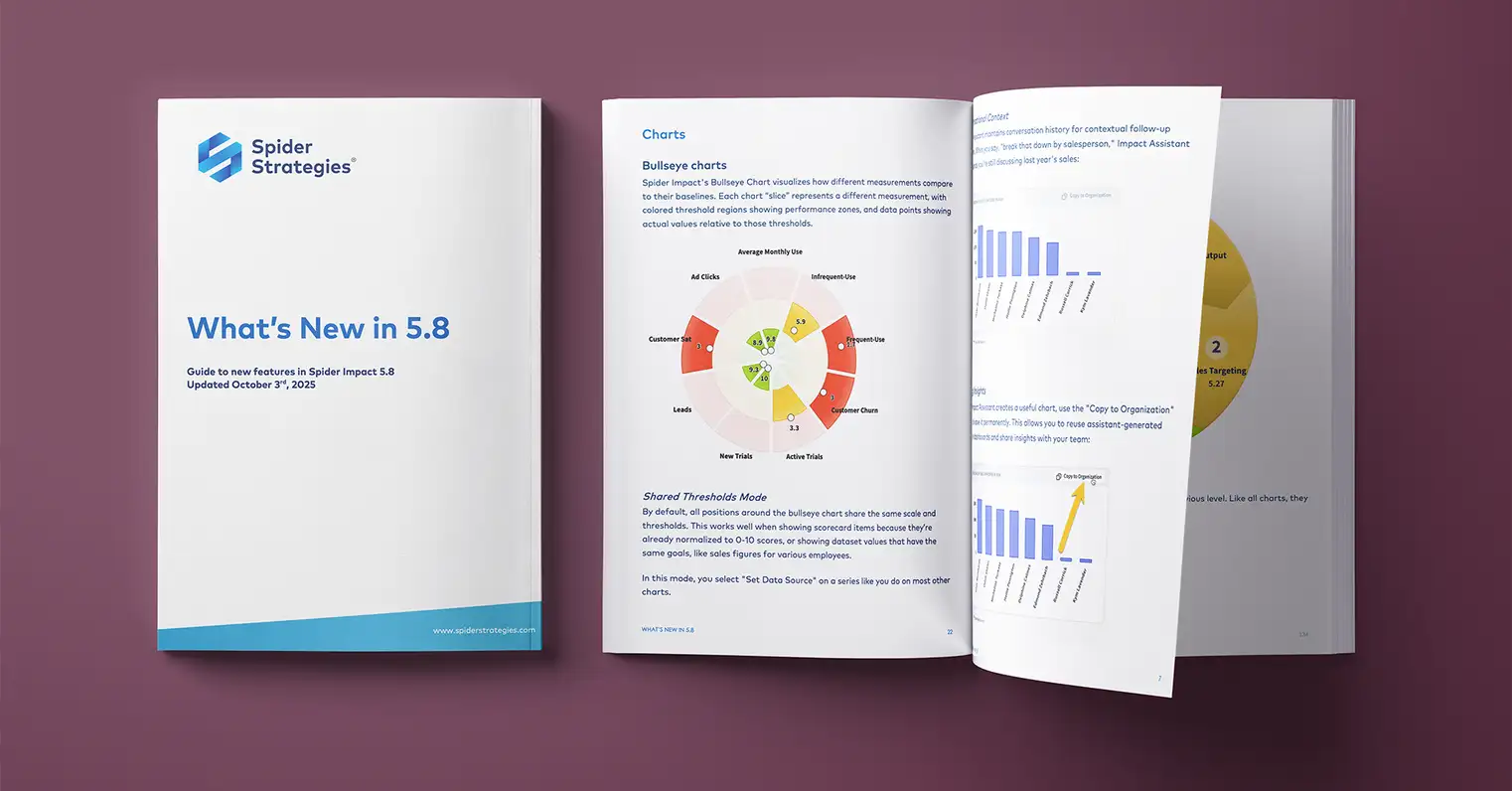Top 5 Benefits of Using Performance Management Software in Your Organization

Is your team busy—but not making strategic progress?
You’re not alone. Many organizations fall short of their goals because daily work isn’t clearly connected to strategic objectives. Spreadsheets, manual updates, and fragmented reporting make it hard to stay aligned and focused.
Performance management software changes that.
It creates a centralized, always-up-to-date view of your strategy—automating data collection, visualizing progress, and building accountability at every level.
No more silos. No more guesswork.
Just clear insights that show how every team contributes to the big picture.
From aligning goals across departments to giving leaders real-time visibility, performance management systems help close the gap between planning and execution—so you can achieve the outcomes that matter most.
Keep reading to discover how the right performance management system can turn your strategic vision into measurable, organization-wide results.
Main Takeaways
-
Strategic Hub: Centralizes your organizational strategy, creating a unified source of truth that helps everyone see how their work drives larger goals.
-
Time-Saving Automation: Eliminates manual data collection and reporting tasks, reducing errors while ensuring consistent, up-to-date information access.
-
Decision-Driving Visuals: Transforms complex data into intuitive dashboards that reveal performance trends, enabling leaders to spot issues early and act decisively.
-
Barrier-Breaking Transparency: Connects teams through shared metrics and goals, fostering collaborative problem-solving across traditional departmental boundaries.
-
Balanced Security: Protects sensitive information through role-based permissions while ensuring appropriate visibility for everyone who needs performance data.
Here Are the Top 5 Benefits of Performance Management Software for Strategy Execution
If you're considering performance management software, it's important to understand what real value it can deliver. Below are the five most impactful ways these platforms support alignment, visibility, and results across your organization.
1. Aligning Teams Around Shared Strategic Goals
When strategic alignment fails, 90% of implementation efforts fall short, as reported by Forbes.
This disconnect wastes valuable resources on initiatives that don't serve your organization's true objectives. The solution isn't more meetings or emails—it's creating a structural foundation for alignment.
Performance management software establishes a single source of truth for your strategic objectives, KPIs, and initiatives. When everyone accesses the same strategic framework through a centralized platform, misinterpretations vanish. Executive decisions cascade consistently throughout your organization, ensuring teams understand not just what the priorities are, but why they matter.
These platforms connect organizational goals to daily work through hierarchical frameworks. This cascading approach transforms abstract corporate objectives into concrete actions at every level. Strategy execution software helps each employee align with shared goals, making their individual contributions to broader success crystal clear.
For example, a corporate goal to improve customer satisfaction might translate to reducing response times for support teams, enhancing user interface for product teams, and implementing specific feature improvements for developers.
This alignment approach delivers measurable business value. When values, skills, structures, and systems align with shared strategy and purpose, profitability improves dramatically.
Visual tools like strategy maps and dashboards transform complex strategic relationships into intuitive, accessible representations. When employees visualize cause-and-effect relationships—how improving operational efficiency drives customer satisfaction, which then increases revenue—strategy becomes tangible rather than theoretical. These visualizations create instant clarity that text-based communication simply cannot match.
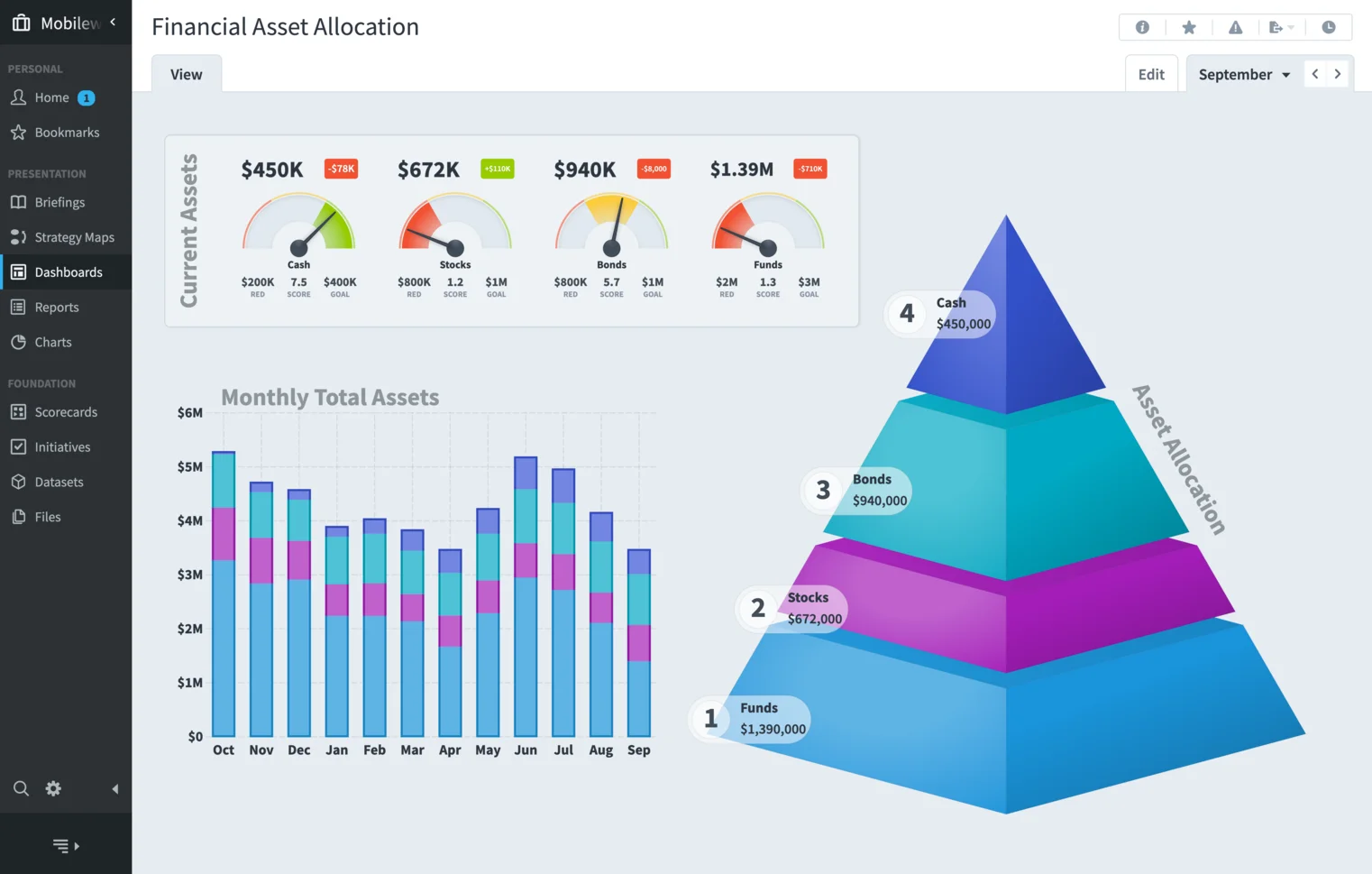
Beyond making strategy visible, these visualization tools reveal interdependencies between departments, naturally breaking down silos through transparency.
When Marketing sees how their campaigns directly affect Sales performance, and Operations understands how their efficiency improvements impact Customer Experience metrics, cross-functional collaboration emerges organically. Teams recognize their interconnectedness and develop a collaborative mindset.
By establishing clear ownership and accountability for every metric and initiative, performance management platforms eliminate the ambiguity that typically derails strategic execution. When teams know exactly who's responsible for what, follow-through improves dramatically, and the right stakeholders can address issues promptly.
This structured approach to strategic alignment provides a foundation for responding to change, allowing your organization to pivot effectively when market dynamics shift—transforming strategy from an annual planning exercise into a living part of daily operations.
2. Automating Performance Data to Save Time and Improve Decisions
Manual data collection creates one of the biggest barriers to effective performance management. It consumes countless hours while producing insights that become outdated before they even reach decision-makers. This administrative bottleneck wastes valuable resources and undermines your organization's ability to respond strategically to changing conditions.
Performance management software eliminates this burden by automating the entire data collection process. Instead of wrestling with manual spreadsheets, these systems connect seamlessly with your existing business applications—including CRM platforms, financial systems, project management tools, and HR databases—to import performance data automatically on predetermined schedules. You get consistently current metrics without the maintenance headache.
The impact goes far beyond efficiency gains. When automation handles routine data collection, your team can shift from gathering information to analyzing it and implementing strategic improvements.
Brookings reports that this reduction in manual data tasks saved around 3,900 person-hours each year in one organization while also reducing overtime and boosting productivity. Teams that previously spent days preparing for quarterly reviews can now invest that time addressing performance issues or developing strategic initiatives.
Dynamic visualization capabilities transform how stakeholders interact with performance data. Rather than static reports that capture a single moment in time, interactive dashboards display real-time metrics with drill-down functionality that lets users explore underlying trends and contributing factors. When executives spot concerning metrics, they can immediately investigate root causes rather than waiting for additional reports.
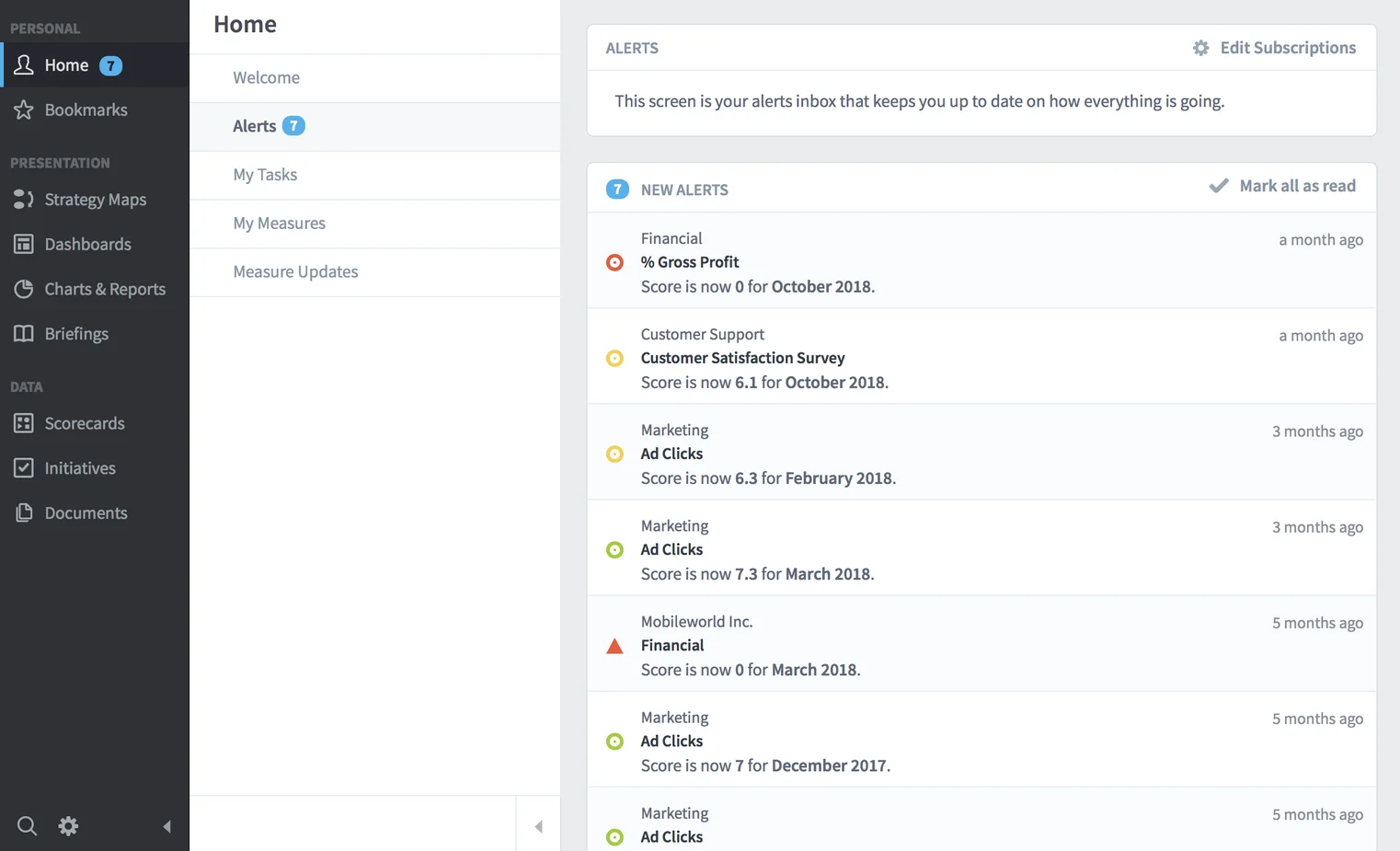
This proactive monitoring serves as an early warning system for your organization. Through automated executive reports, stakeholders receive immediate notifications when metrics approach or cross predetermined thresholds, enabling teams to address emerging issues before they escalate into significant problems.
For organizations conducting regular performance reviews, the automation extends to presentation preparation, with dynamic slides pulling current data directly from the system—ensuring everyone works from the same accurate information.
The business impact of this automation is substantial. Recent research shows that tracking well-defined KPIs for solutions has the most impact on bottom line, yet less than one in five organizations do this effectively. Experts confirm that a well-designed KPI framework provides accurate feedback on business performance, with best-in-class companies seeing a 10% increase in time-to-decision making.
By transitioning from manual data management to one automated system for capturing and analyzing metrics, your organization develops a fundamentally more agile approach to performance management.
As you automate more of your performance data collection, ensuring this valuable information remains secure while accessible becomes increasingly important—a challenge we'll explore in the next section.
3. Securing Strategic Data Without Sacrificing Accessibility
Performance management systems face a critical balancing act: providing stakeholders with necessary insights while protecting sensitive information. This challenge intensifies as teams distribute globally and data volumes grow.
Without sophisticated safeguards, your organization risks either exposing strategic information or creating bottlenecks that hinder decision-making.
Modern performance management software solves this challenge through intelligent role-based permissions that create personalized information landscapes for each user. This targeted approach ensures executives maintain comprehensive visibility across the organization while department managers access only data relevant to their responsibilities. Sales directors can view territory performance within company-wide goals, while marketing managers see campaign metrics tied to lead generation—all within the same secure system.
These permission structures don't just restrict access—they create tailored experiences delivering exactly what each stakeholder needs. By implementing a proper data governance framework, you effectively balance people, processes, and technology to maintain both security and accessibility.
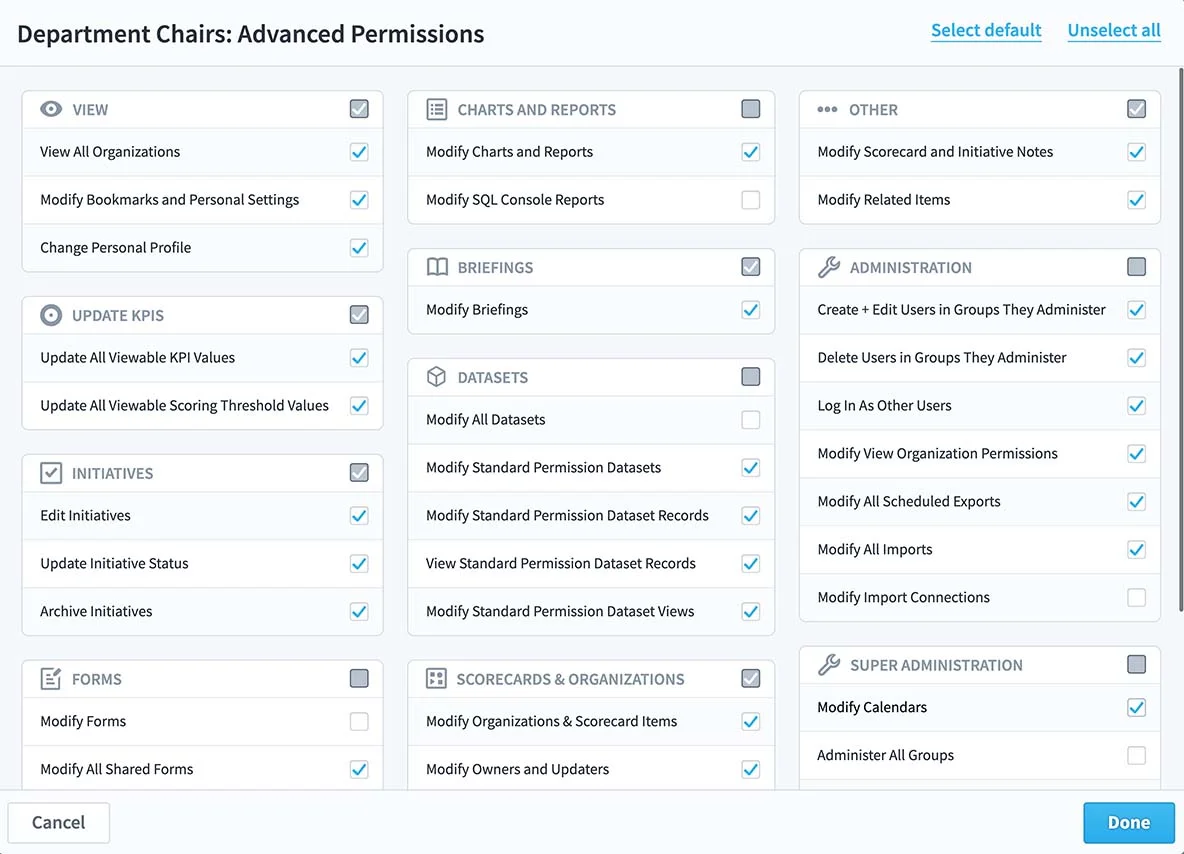
Comprehensive audit trails complement access controls by creating accountability throughout the system. These trails track who accessed specific information and when, supporting compliance requirements while enabling security teams to identify concerning patterns. This protection layer proves particularly vital for federal government agencies where robust data governance safeguards against unauthorized access that could compromise operational integrity.
Security architecture extends seamlessly to reporting capabilities, automatically filtering information based on user roles and responsibilities. According to Forbes,
"Once you've settled on metrics, continuous monitoring, reviewing and adjusting the KPIs is also a necessary step to ensure they remain aligned with changing business environments and strategies."
This ongoing adaptation becomes significantly more manageable when built upon secure, role-appropriate information delivery systems.
Many organizations succeed with incremental security implementation approaches. Boston Consulting Group highlights that "as part of its new governance model, the university hospital has developed a balanced scorecard that includes KPIs in four key areas," demonstrating how organizations can establish core metrics with appropriate security protocols before expanding across additional domains.
Advanced data governance tools enhance this security framework by automating data management while maintaining strict protection protocols. Department heads receive tailored analytics showing their team's performance within broader strategic contexts, while individual contributors access metrics directly relevant to their responsibilities—all within security boundaries that protect sensitive information.
By striking this optimal balance between accessibility and protection, performance management software creates a secure environment where data-driven decision-making flourishes without compromising information integrity. This security foundation becomes the essential platform upon which truly transformative performance management can be built.
4. Breaking Down Silos to Drive Cross-Functional Collaboration
When departments operate in isolation, progress stalls—even if individual teams are performing well. Siloed work leads to duplicated efforts, inconsistent reporting, and missed opportunities to align on shared strategic outcomes.
In fact, a study by Deloitte found that 83% of digitally maturing organizations prioritize cross-functional collaboration as a key business capability.
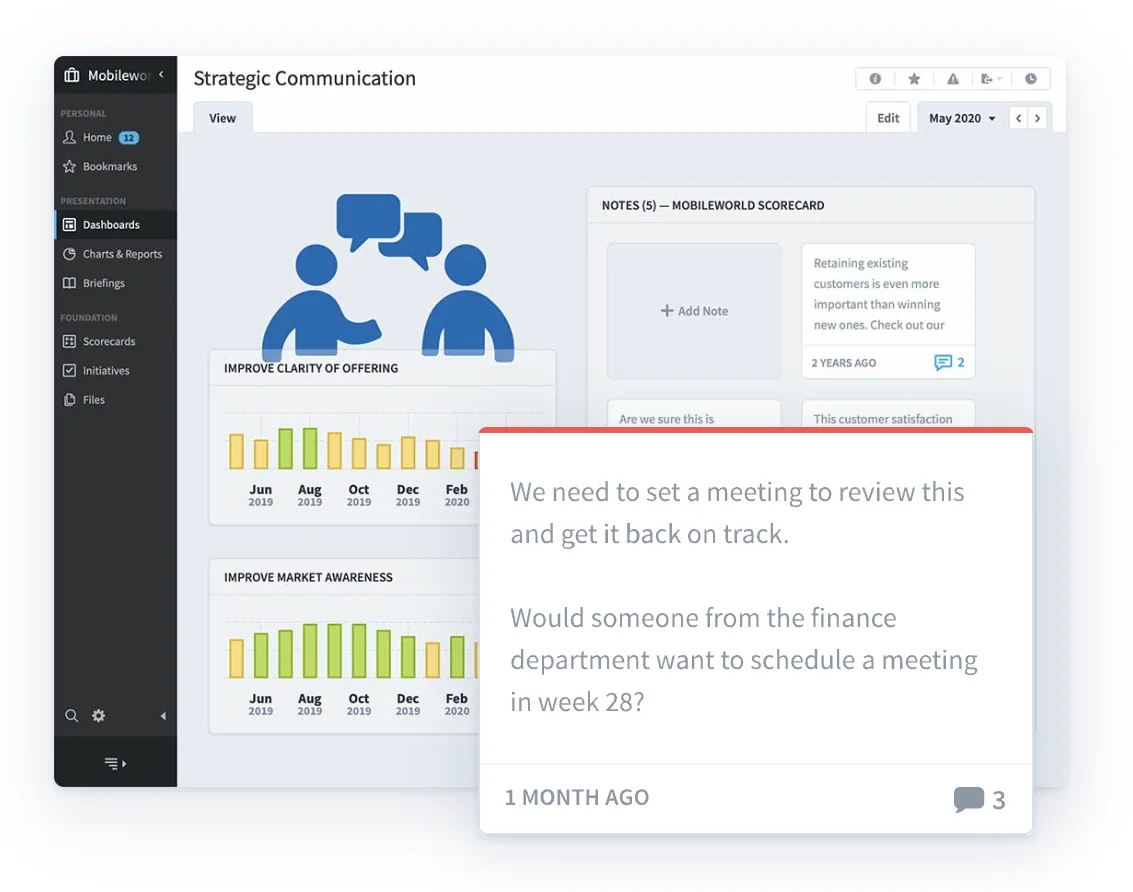
Performance management software breaks down these barriers by creating visibility across teams, departments, and business units. Instead of isolated systems and spreadsheets, everyone works from the same platform with access to role-relevant dashboards, scorecards, and initiative tracking.
When teams see how their performance connects to others', they naturally identify dependencies, avoid redundancy, and align priorities.
Shared ownership of strategic objectives also encourages open dialogue and joint problem-solving. For example, if a lagging customer experience metric affects both operations and support, the shared KPI draws attention to the issue and prompts cross-departmental action. This fosters a culture where teams don’t just report on their performance—they collaborate to improve it.
➡️ Explore more ways to build this kind of performance-driven culture in our eBook: Building a Performance-Driven Culture.
When leaders are aligned on purpose and strategic intent, collaborative decision-making becomes easier and faster—a key benefit of making strategy execution visible across teams.
These tools also give leadership a more holistic view of execution. Instead of piecing together updates from multiple departments, executives gain a real-time picture of how all parts of the organization are contributing to strategic success. This clarity improves both tactical adjustments and long-term decision-making.
By making performance visible across silos, performance management software reinforces shared goals, creates accountability, and helps teams move forward together—faster and more effectively.
5. Accelerating Agility Through Real-Time Insights
Markets change fast—and so should your strategy. But many organizations struggle to pivot quickly because they’re relying on outdated or incomplete performance data.
Without real-time visibility, you're always reacting instead of proactively managing change.
Performance management platforms give you the agility to respond in the moment—not after the fact. Real-time dashboards and threshold alerts allow leaders to track progress continuously, identify risks early, and adjust course before issues become crises. When strategic data is live and accessible, there's no need to wait for monthly reports or end-of-quarter reviews to make decisions.
Agility isn’t just about reacting—it’s about learning and improving. When you can measure the impact of strategic initiatives in real time, you gain insight into what’s working and where resources should be redirected. For instance, if a new initiative to reduce churn is underperforming, you can investigate, adjust tactics, or reallocate funds before the full quarter is over.
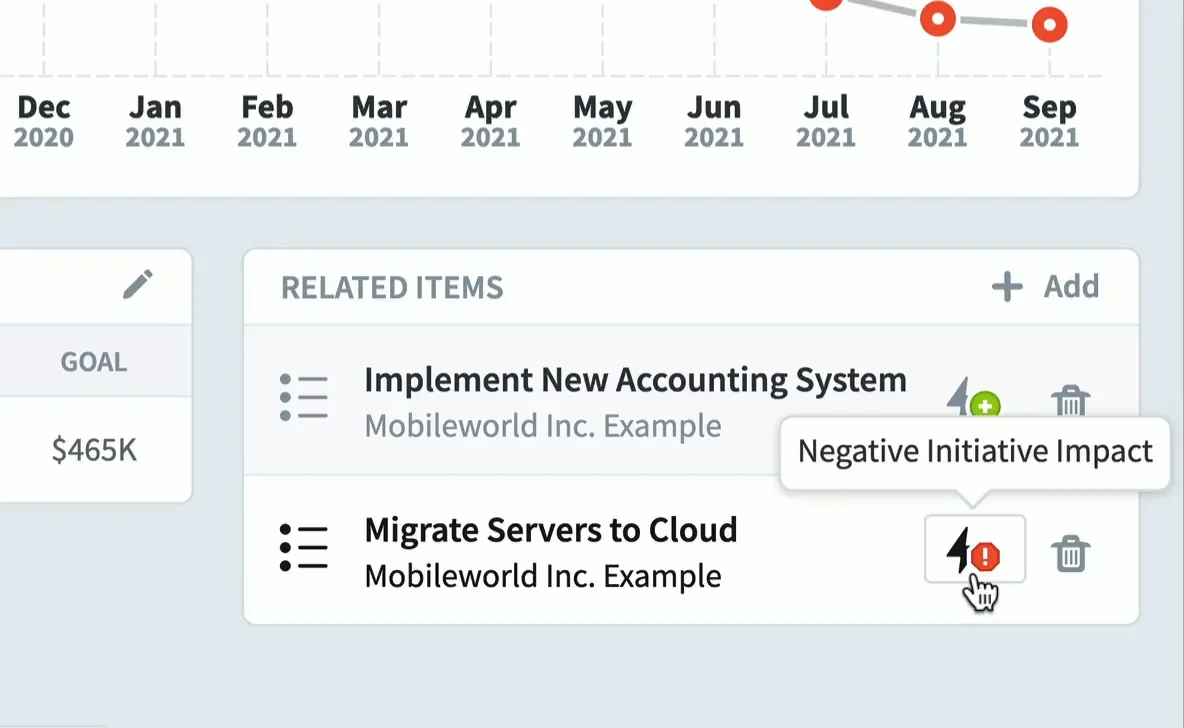
This speed-to-insight is especially critical for organizations facing digital transformation or competitive disruption. It's been shown that companies who adapt quickly to change outperform others, but that agility depends on having accurate data delivered at the right time—something only performance management platforms designed for real-time use can provide.
With this kind of system in place, your strategic plan becomes a living, breathing framework—constantly updated and refined based on real-world performance. That’s how you stay ahead of change, not just respond to it.
Transform Your Strategic Execution
Implementing performance management software transforms your strategic execution much like upgrading from a paper map to a GPS system that adapts to changing conditions in real time.
You'll see immediate benefits—streamlined meetings and easier data access—while developing deeper strategic advantages like stronger organizational alignment and more agile decision-making.
The best solutions adapt to your organization's unique structure rather than forcing disruptive process changes. Whether you use Balanced Scorecard methodology, OKRs, or a custom framework, your performance management software should flex to your approach while providing guidance when needed.
Start with a focused pilot in one department to demonstrate value quickly while creating internal champions who drive adoption across other teams. This phased implementation minimizes disruption while maximizing buy-in at all levels.
As your strategic execution improves, the return on investment becomes increasingly clear through significant time savings, enhanced cross-departmental collaboration, and measurable progress toward strategic goals that previously seemed impossible to track effectively.
Take the Next Step Toward Strategic Excellence
Ready to elevate your organization's performance management?
Take our Strategic Health Check in just three minutes to gain valuable insights into your strategic execution capabilities.
This quick assessment identifies your strengths and reveals immediate improvement opportunities tailored to your organization's unique needs. You'll receive a customized PDF report with actionable recommendations that benchmark your performance against industry leaders.
Ready to see how Spider Impact in action? Request a demo.
Frequently Asked Questions
How does performance management software improve strategic alignment?
Performance management software improves strategic alignment by establishing a single source of truth for your strategic objectives, KPIs, and initiatives. It creates a centralized platform where everyone can access the same strategic framework, eliminating misinterpretations and ensuring consistent cascading of executive decisions throughout the organization. These solutions connect organizational goals to daily work through hierarchical frameworks, transforming abstract corporate objectives into concrete actions at every level, making individual contributions to broader success clear for each employee.
What are the automation benefits of performance management software?
Performance management software eliminates the administrative burden of manual data collection by automating the entire process. These systems connect seamlessly with existing business applications to import performance data automatically on predetermined schedules, providing consistently current metrics without maintenance headaches. This automation saves thousands of person-hours annually while reducing overtime and boosting productivity. Teams previously occupied with gathering data can shift focus to analyzing it and implementing strategic improvements, making the organization fundamentally more agile in its approach to performance management.
How do visualization tools in performance management software enhance decision-making?
Visualization tools like strategy maps and dashboards transform complex strategic relationships into intuitive, accessible representations that create instant clarity text-based communication cannot match. Instead of static reports capturing a single moment, interactive dashboards display real-time metrics with drill-down functionality, allowing users to explore underlying trends and contributing factors. When executives spot concerning metrics, they can immediately investigate root causes rather than waiting for additional reports. These visual tools also reveal interdependencies between departments, naturally breaking down silos through transparency and fostering cross-functional collaboration.
How does performance management software balance security with accessibility?
Modern performance management software balances security with accessibility through intelligent role-based permissions that create personalized information landscapes for each user. This targeted approach ensures executives maintain comprehensive visibility while department managers access only data relevant to their responsibilities. Comprehensive audit trails complement these controls by tracking who accessed specific information and when, supporting compliance requirements and enabling security teams to identify concerning patterns. The security architecture extends to reporting capabilities, automatically filtering information based on user roles while maintaining appropriate strategic context.
What's the best approach for implementing performance management software?
The best approach for implementing performance management software is to start with a focused pilot in one department to demonstrate value quickly while creating internal champions who drive adoption across other teams. Choose solutions that adapt to your organization's unique structure rather than forcing disruptive process changes - whether you use Balanced Scorecard methodology, OKRs, or a custom framework. This phased implementation minimizes disruption while maximizing buy-in at all levels. As strategic execution improves, the return on investment becomes increasingly clear through time savings, enhanced cross-departmental collaboration, and measurable progress toward previously difficult-to-track strategic goals.
Demo then Free Trial
Schedule a personalized tour of Spider Impact, then start your free 30-day trial with your data.



